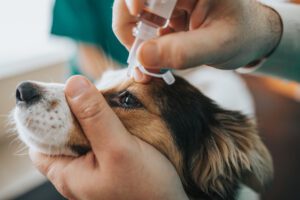Dog Styes: When is a Stye on Your Dog’s Eye Considered an Emergency?
Does your dog have a stye on their eye, and you wonder if it is an emergency? A stye is extremely painful for a pup. If you want to know more about dog styes, check out this informative article.

What is a Stye?
A stye in dogs is a small, swollen, painful red bump that can develop on the upper or lower eyelid. It is equal to a human having a pustule. Dirt and debris get trapped around the eye, clogging the hair follicles close to the eyelid. The oils inside the stye become infected, developing pus, a severe problem. A stye can lead to eye disease in dogs and, if left untreated, can result in corneal damage and impair your pup’s vision.
The same bacteria in the stye can also cause infections of the heart valves, pneumonia, and bone infections. The bacteria are spread through direct interaction, through the air, and when the contaminated areas are touched. Canines, people, and other animals can have eye problems, and styes are very uncomfortable and require immediate attention.
Causes
Dogs become infected due to an overgrowth of bacteria or a compromised immune system. Eye irritation can perpetuate it. However, there are also some other causes:
- Allergy
- Viruses
- Parasites
- Eye injury
- Glaucoma
- Ocular ulcers
- Conjunctivitis
- Constant rubbing
Autoimmune diseases and canine influenza can also cause a stye to form. Styes are often confused with cherry eye, which is a condition that results in the prolapse of the third eyelid.
Signs
The medical term for a stye is “hordeolum,” which is how vets refer to it. If you spot any of the subsequent indicators, your canine may have a stye:
- Eye swelling
- Redness in the eye
- Broken abscess with pus
- Inflammation on the eyelid
If your pup has redness or swelling around the eye, a veterinarian should check it immediately. You do not want to risk it affecting your canine companion’s eyesight.
Treatment
The following includes veterinary treatment for styes:
Antibiotics or Medication
Depending on the intensity of the infection, a topical antibiotic cream, eye wash, or oral medication can be prescribed by your vet to treat your dog’s stye. You apply the antibiotic cream to the affected spot. An eyewash can be administered, or you can give your pup oral medication in their food.
Oral medications may be best if your pup does not respond well to the cream or eye wash. Oral medicine may consist of anti-inflammatories to treat pain and swelling. If it is a serious case, cortisone may also be ordered to reduce inflammation better.
Professional Removal
Often, styes go away on their own without any intervention from the vet. Veterinarians usually try a less invasive form of treatment before they decide to move forward with professional removal of the stye. Professional removal is usually only considered if the stye worsens or affects your pup’s vision.
To accomplish removal, the vet will open the stye with a scalpel or needle to drain the pus from the infected area. This draining typically involves sedation to prevent your dog from being overly anxious during the procedure. Once the stye has been opened, an eye wash will be used to help keep the location clean.
Can a Stye Be Prevented?
Helping prevent a stye from occurring on your dog in the first place is essential, as your pup’s eye health needs to be a priority. Cleaning the dirt and debris trapped in the eye is a huge part of helping your dog. The following includes some ways to help prevent styes:
- Manage your dog’s environmental allergies
- Keep the fur around your dog’s eyes well-groomed
- Clean your dog’s face properly when bathing them
- Do not open the windows in your home on windy days
- Have your pup wear protective doggie glasses when you take them out
If your dog is susceptible to styes, you should clean your pup’s face daily to prevent the accumulation of dirt and debris on their eyelid.
When is a Dog Stye an Emergency?
You should consult your veterinarian whenever there is a problem with your dog’s eyes. Any trouble with the eyes can lead to visual disturbance and, at times, even loss of sight. Eye infections can also be painful for your pup. Occasionally a stye starts small, then gets very large and must be removed. It is imperative to ensure that the stye is not affecting your dog’s ability to see or cause discomfort. A vet can also help prevent the problem from recurring.
Seek Veterinary Care if Your Dog Has a Stye
A stye can be uncomfortable for your dog and may compromise their vision. You can treat your canine at home with a warm compress if your dog tolerates it. If your canine companion has a stye on their eye that becomes large or painful, take your canine to the vet as soon as possible. For pet emergencies in Atlanta, GA, call The Village Vets at (404) 371-9774.

